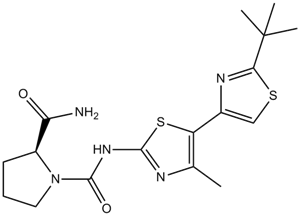A66 (Synonyms: A 66; A-66) |
| Catalog No.GC17550 |
P110α inhibitor
Products are for research use only. Not for human use. We do not sell to patients.

Cas No.: 1166227-08-2
Sample solution is provided at 25 µL, 10mM.
A66 is a potent and selective p110α inhibitor with IC50 of 32 nM.
P110α is the catalytic subunit of a class I Phosphatidylinositol-4,5-bisphosphate 3-kinase catalytic that is composed of a 85 kDa regulatory subunit and a 110 kDa catalytic subunit.
A66 treatment inhibits phosphorylation of Akt/PKB in certain cell lines that have H1047R mutation in PIK3CA and high levels of p110a [1]. A66 prolonged treatment reduced phosphorylation of S6K on Thr389, a marker of activity of this kinase and prevent IRS downregulation induced by chronic insulin treatment in both C2C12 myoblasts and 3T3-L1 adipocytes [2].
The component has also been used extensively in various animal models to study the role of PI3K. For instance, inhibition of p110α by A66 treatment was shown to reduce tumor growth of certain cell lines in in vivo xenograft models [1]. Chronic pharmacological inhibition of p110α through A66 treatment protects from insulin resistance induced by sustained metabolic stress [2]. In the mouse model of mammary fat pad transplantation of athymic mice with primary tumors, treatment of transplanted tumor-bearing mice with A66 reduce tumor growth dramatically [3].
References:
1.Jamieson S, Flanagan JU, Kolekar S, Buchanan C, Kendall JD, Lee WJ, et al. A drug targeting only p110alpha can block phosphoinositide 3-kinase signalling and tumour growth in certain cell types. Biochem J 2011,438:53-62.
2.Foukas LC, Bilanges B, Bettedi L, Pearce W, Ali K, Sancho S, et al. Long-term p110alpha PI3K inactivation exerts a beneficial effect on metabolism. EMBO Mol Med 2013,5:563-571.
3.Utermark T, Rao T, Cheng H, Wang Q, Lee SH, Wang ZC, et al. The p110alpha and p110beta isoforms of PI3K play divergent roles in mammary gland development and tumorigenesis. Genes Dev 2012,26:1573-1586.
Average Rating: 5 (Based on Reviews and 20 reference(s) in Google Scholar.)
GLPBIO products are for RESEARCH USE ONLY. Please make sure your review or question is research based.
Required fields are marked with *




















